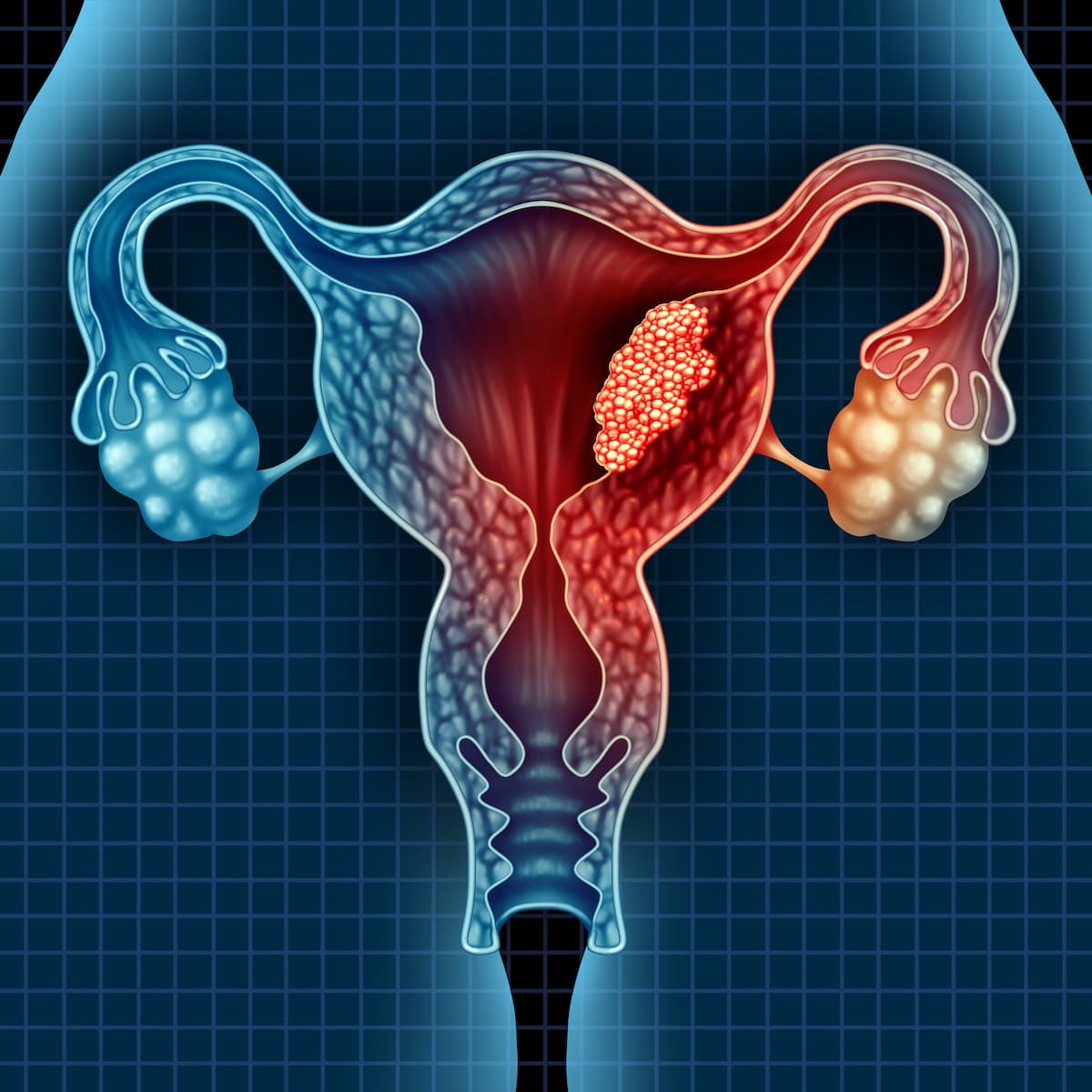Endometrial Cancer Molecular Classification May Predict Radiotherapy Response
Cutting out radiotherapy appears to be safe while improving quality of life in patients with POLE-mutated endometrial cancer.
"Omitting radiotherapy is safe in [patients] with POLE-mutated [endometrial cancer] and will reduce toxicity, improve quality of life, and reduce health care utilization and costs," according to the study authors.

Molecular classification may be predictive of outcomes with radiotherapy and help guide adjuvant treatment decision-making for patients with stage I endometrioid endometrial cancer, according to findings from a study published in Journal of Clinical Oncology.
Across a cohort of patients with molecularly classified endometrial cancer who were included in the intent-to-treat population of the PORTEC-1 trial (n = 484), there was no disease recurrence in patients with POLE-mutated endometrial cancer. Additionally, the rate of vaginal recurrence was 6.4%, and pelvic recurrence was noted in 4.9% of those with mismatch repair deficient (dMMR) disease. The corresponding rates were 24.4% and 6.2% for patients with endometrial cancer harboring a p53 abnormality and 10.0% and 2.2% in those with no specific molecular profile, respectively.
In the PORTEC-1 trial population, 5-year locoregional recurrence-free survival was 97.4% (95% CI, 95.3%-99.5%) for those receiving external beam radiotherapy (EBRT) and 88.3% (95% CI, 84.3%-92.5%) for those who did not receive adjuvant therapy (P = 6.0x10–4). The corresponding 5-year locoregional recurrence-free survival rates were 95.7% (95% CI, 91.0%-100.0%) and 90.3% (95% CI, 83.2%-98.0%) for those with dMMR endometrial cancer (P = .52), 96.2% (95% CI, 89.0%-100.0%) and 72.2% (95% CI, 54.2%-96.2%) in those with endometrial cancer harboring a p53 abnormality (P = .15), and 98.3% (95% CI, 96.1%-100.0%) and 87.7% (95% CI, 82.4%-93.4%) in those with no specific molecular profile (P = 4.6x10–4).
Among 396 patients with molecularly defined endometrial cancer included in the phase 3 PORTEC-2 trial (NCT00376844), the 5-year vaginal recurrence-free survival rate was 97.8% among those receiving vaginal brachytherapy (VBT) and 97.9% with EBRT (P = .98). Additionally, the 5-year pelvic recurrence rate in each respective arm was 94.6% and 98.9%, respectively (P = .010).
In the PORTEC-2 trial population, no patients with POLE-mutated endometrial cancer experienced pelvic recurrence. The 5-year pelvic recurrence-free survival rates among those receiving EBRT and VBT, respectively, were 100.0% vs 96.2% (95% CI, 91.1%-100.0%) in those with dMMR disease (P = .20), 100.0% and 68.6% (95% CI, 48.8%-96.3%) in those with disease harboring a p53 abnormality (P = .055), and 98.2% (95% CI, 95.8%-100.0%) and 97.2% (95% CI, 94.2%-100.0%) in those with no specific molecular profile (P = .38).
“Results of this study support decisions on adjuvant therapy,” the study authors wrote. “Omitting radiotherapy is safe in [patients] with POLE-mutated [endometrial cancer] and will reduce toxicity, improve quality of life, and reduce health care utilization and costs.”
They continued, “[Patients] with stage I [endometrial cancer with no specific molecular profile] have significant benefit from adjuvant radiotherapy. Here, VBT is the treatment of choice as it is as effective as EBRT but has a much milder toxicity profile. This implies that assessment of the molecular classification is needed to provide [patients] with stage I [endometrioid endometrial cancer] with the most suitable adjuvant treatment strategy.”
Investigators of this study assessed data from the PORTEC-1 trial evaluating pelvic EBRT vs no adjuvant therapy among patients with early-stage intermediate-risk endometrial cancer. Analysis also included findings from the PORTEC-2 trial comparing VBT with EBRT in early-stage, high-/intermediate-risk endometrial cancer.
Outcomes of the primary analysis of this study included locoregional recurrence-free survival by treatment across molecular classes in the PORTEC-1 and PORTEC-2 studies. Investigators also conducted a secondary analysis in which they pooled data from the PORTEC-1 and PORTEC-2studies to evaluate locoregional recurrence-free survival rates.
In the PORTEC-1 and PORTEC-2 populations, the respective median patient ages at time of random assignment were 67 years and 69 years. Most patients in each respective population had grade 1 to 2 endometrioid disease (82.9% and 86.9%), stage IB disease (58.3% vs 81.8%), and no lymphovascular space invasion (82.0% and 77.5). Across the 4 molecular classes, most patients in each population had no specific molecular profile (54.8% and 58.6%) followed by dMMR disease (28.3% and 27.8%), disease with p53 abnormality (8.3% and 7.6%), and POLE-mutated disease (8.7% and 6.1%).
In the combined cohort of 880 patients, 5-year locoregional recurrence-free survival rates were 97.1% (95% CI, 95.5%-98.7%) with EBRT, 93.0% (95% CI, 89.4%-96.7%) with VBT, and 88.3% (95% CI, 84.3%-92.5%) with no adjuvant treatment (P = .0001). The corresponding rates with each respective treatment were 94.2% (95% CI, 90.1%-98.5%), 94.2% (95% CI, 87.9%-100.0%), and 90.3% (95% CI, 83.2%-98.0%) for the dMMR group (P = .74). Additionally, the corresponding values were 96.9% (95% CI, 91.0%-100.0%), 64.3% (95% CI, 44.8%-92.3%), and 72.2% (95% CI, 54.2%-96.2%) in the p53 abnormality group (P = .048), as well as 98.3% (95% CI, 96.6%-100.0%), 96.2% (95% CI, 92.7%-99.9%), and 87.7% (95% CI, 82.4%-93.4%) in the no specific molecular profile group (P = 5.0x10–5).
Based on a sensitivity analysis, cumulative rates of pelvic and locoregional recurrences were comparable to the estimates of locoregional and pelvic recurrence-free survival as determined with the Kaplan-Meier method.
Reference
Horeweg N, Nout RA, Jürgenliemk-Schulz IM, et al. Molecular classification predicts response to radiotherapy in the randomized PORTEC-1 and PORTEC-2 trials for early-stage endometrioid endometrial cancer. J Clin Oncol. Published online July 24, 2023. doi:10.1200/JCO.23.00062
Elevating the Quality of Cancer Care via Cross-Department Collaboration
Experts from Sibley Memorial Hospital discuss how multidisciplinary work has enhanced outcomes such as survival and resource use at their institution.